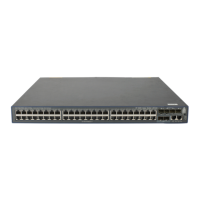242
Field Descri
tion
PSE power supported
Indicates whether or not the LLDP neighboring device can operate as
a PSE.
PSE power enabled
Indicates whether or not the LLDP neighboring device is operating as
a PSE.
PSE pairs control ability
Indicates whether or not the PSE-PD pair control is available on the
LLDP neighboring device.
Power pairs
PoE mode of the LLDP neighboring device:
• Signal—PoE via signal lines
• Spare—PoE via spare lines
Port power classification
Port power classification of the PD of the LLDP neighboring device:
• Class 0
• Class 1
• Class 2
• Class 3
• Class 4
Power type
This field appears only on the devices that support PoE+.
PD type of an LLDP neighboring device which is a PD device:
• Type 1 PD—Receives a power of 0 W to 15.4 W, a voltage of 44
V to 57 V, and a current of up to 350 mA.
• Type 2 PD—Receives a power of 0 W to 30 W, a voltage of 50 V
to 57 V, and a current of up to 600 mA.
Power source
This field appears only on the devices that support PoE+.
Power source type of an LLDP neighboring device which is a PD
device:
• Unknown—Unknown power supply
• PSE—PSE power supply
• Local—Local power supply
• PSE and local—PSE and local power supplies
Power priority
This field appears only on the devices that support PoE+.
PoE power receiving priority of ports on an LLDP neighboring device
which is a PD device:
• Unknown
• Critical
• High
• Low
PD requested power value
This field appears only on the devices that support PoE+.
Power (in W) that the LLDP neighboring device which is a PD device
requests.
PSE allocated power value
This field appears only on the devices that support PoE+.
Power (in W) that the PSE provides to the LLDP neighboring device
which is a PD device.
Link aggregation supported
Indicates whether or not link aggregation is supported on the port that
connects the LLDP neighboring device to the local device.

